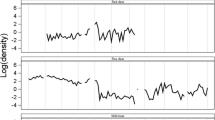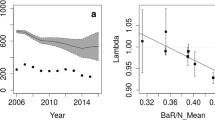Summary
The huemul(Hippocamelus bisulcus), an endangered deer living in the Andes of southern South America, numbers 600–700 in Argentina, from at least 63 fragmented subpopulations. Very limited information exists on most populations, but there are indications that the distribution and population sizes continue to diminish, possibly through reduced reproductive rates, elevated mortality rates or both. This is the first analysis of the population ecology of a subpopulation in Argentina, made possible through the only existing compilation of numerous remains of dead huemul (n=19). Surveys were conducted between 1993 and 1999 to locate and collect remains, which were found concentrated at lower elevations. The sex ratio of adults and subadults (n=12) was 1:1, but could not be determined for fawns. Clear signs of predation was found in 37% of all deer: 50% among calves, 50% among subadults and 31% among adults. These signs occurred in 29% of adult females and 50% of adult males. Deaths occurred during winter as judged by the state of the male skulls, which indicated the phase of the antler cycle. Femur fat content of 3 deer averaged 93%. Predation signs frequently were clearly from puma(Puma concolor), which is the only natural predator of huemul. The high predation rate, high marrow fat content and no indications of deaths resulting from disease corroborate the pristine state of the of mature lenga(Nothofagus pumilio) forest. The area with a concentration of huemul carcasses appears to be the huemul's major winter habitat.
Zusammenfassung
In Argentinien leben noch 600 bis 700, auf mindestens 63 fragmentierte Subpopulationen verteilte Individuen des Huemul, einer gefährdeten Hirschart der Anden des südlichen Südamerika. Über die meisten dieser Bestände ist nur sehr wenig bekannt. Es gibt jedoch Hinweise darauf, dass sowohl die Verbreitung als auch die Größe der Bestände rückläufig sind, vermutlich infolge abnehmender Reproduktionsraten und/oder erhöhter Mortalität. Basierend auf der Zusammenstellung von Totfunden (n=19, Konzentration in unteren Höhenstufen) des Zeitraums 1993 bis 1999, wird hier erstmals eine Untersuchung zur Populationsökologie einer argentinischen Subpopulation des Huemul vorgelegt. Das Geschlechterverhältnis bei adulten und subadulten Individuen betrug 1:1, für Kälber konnte es nicht bestimmt werden. Deutliche Hinweise auf Prädation als Todesursache fanden sich bei 37% aller Individuen (Kälber 50%, Subadulte 50%, Adulte 31%). 29% der adulten Weibchen und 50% der adulten Männchen wiesen Anzeichen eines Todes infolge Prädation auf. Bei den Männchen konnte anhand des Schädelbefundes (Phase des Geweihzyklus) auf einen Tod während des Winters geschlossen werden. Der Fettgehalt des Knochenmrks im Oberschenkelknochen drier Individuen betrug im Mittel 93%. Die an den Kadavern gefundenen Prädationszeichen konnten vielfach dem Puma(Puma concolor) zugeordnet werden, dem einzigen natürlichen Feind des Huemul. Die hohe Prädationsrate, der hohe Fettgehalt des Knochenmarks und das Fehlen von Anzeichen für Krankheiten als Todesursache belegen den ursprünglichen Zustand des Lenga(Nothofagus pumilio) Waldes. Das Gebiet mit der Konzentration der Huemul-Kadaver scheint das Haupt-Winterhabitat des Bestandes zu sein.
Résumé
L'Huémul(Hippocamelus bisulcus), une espèce de Cerf menacée vivant dans les Andes de l'Amérique du Sud, présente un niveau de population de quelque 600 à 700 têtes en Argentine, constituée d'au moins 63 sous-populations fragmentées. On dispose de très peu d'informations à propos de la plupart de ces sous-populations mais il est des indications comme quoi leur distribution et leur taille continuent à diminuer, sans doute en raison d'un taux de reproduction réduit, d'un taux de mortalité élevé ou des deux à la fois. Ceci constitue la première analyse démécologique d'une sous-population argentine, rendue possible par la seule compilation existante de restes de huémuls retrouvés morts (n=19). Des recherches ont été menées entre 1993 et 1999 pour localiser et collecter des restes, retrouvés pour la plupart en des endroits situés à faible altitude. La sex-ratio des adultes et sub-adultes (n=12) se situe à 1:1, mais n'a pu être déterminée pour les faons. Des traces évidentes de prédation ont été trouvées dans 37 % des cas : 50 % parmi les faons, 50 % parmi les sub-adultes et 31% parmi les adultes. Ces traces concernaient 29 % de femelles adultes et 50 % de mâles adultes. Les mortalités intervinrent au cours de l'hiver, comme il ressort de l'état des crânes des mâles, lesquels indiquaient la phase en cours du cycle des bois. La teneur en matières grasses du fémur de 3 sujets était de 93 % en moyenne. Souvent, les traces de prédation pouvaient clairement être attribuées au Puma (Puma concolor), seul prédateur naturel de l'Huemul. Le taux de prédation élevé, la teneur élevée en graisse au niveau de la moëlle et l'absence d'indications de mortalités résultant de maladies corroborent le pristine état de la forêt de Lenga (Nothofagus pumilio) parvenue au stade de pleine maturité. L'espace où se concentrent les carcasses de l'Huemul apparaît constituer l'habitat majeur de l'espèce au cours de l'hiver.
Similar content being viewed by others
References
Adams, L. G., Singer, F. J.;Dale, B. W., 1995: Caribou calf mortality in Denali National park, Alaska. J. Wildl. Manage.59, 584–594.
Adrian, W. J., 1992: Wildlife forensic field manual. Assoc. Midwest Fish and Game Law Enforcement Officers, Colorado Division of Wildlife, CO, USA. 179 pp.
Anderson, A. E.;Bowden, D. C.;Kattner, D. M., 1992: The puma on Uncompahgre Plateau, Colorado. Techn. Publ. No. 40. Ft. Collins, Colorado, USA: Colorado Division of Wildlife, 116 pp.
Ballard, W. B.;Ayres, L. A.;Krausman, P. R.;Reed, D. J.;Fancy, S. G., 1997: Ecology of wolves in relation to a migratory caribou herd in Northwest Alaska. Wildl. Monogr.135, 1–47.
Beltran, J. F.;Aldama, J. I.;Delibes, M., 1992: Ecology of the Iberian lynx in Donana, SW Spain. In:Bobek, B.;Perzanowski, K.;Regelin, W. L. (eds.) Global trends in wildlife management. Vol. 2. Krakow, Poland: Swiat Press, pp. 331–334.
Conaf (Chile), 1989: Guia de manejo Reserva Nacional Lago las Torres. Documento de Trabajo No. 17, 45 pp.
Connolly, G. E., 1978: Predators and predator control. In:Schmidt, J. L.;Gilbert, D. L. (eds.) Big Game of North America. Harrisburg, PA, USA: Stackpole Books, pp. 369–394.
Dimitri, M. J., 1972: La region de los bosques Andino-Patagónicos. Colección científica del INTA. INTA, Buenos Aires. 381 pp.
Edwards, J. K.;Marchinton, R. L.;Smith, G. F., 1982: Pelvic girdle criteria for sex determination of white-tailed deer. J. Wildl. Manage.46, 544–547.
Erlinge, S. G.;Goeransson, G.;Hoegstedt, G.;Jansson, G.;Liberg, O.;Loman, J. I.;Nilsson, T.;von Schantz, T.;Sylven, M., 1984: Can vertebrate predators regulate their prey? Am. Naturalist123, 125–133.
Flueck, W. T., 2000: Population regulation in large northern herbivores: evolution, thermodynamics, and large predators. Zeits. Jagdwiss.46, 139–166.
Flueck, W. T.;Smith-Flueck, J. M., 1996: Kann Energiemangel ein Massensterben unter Cerviden in Sommereinständen der nördlichen Gebirge verursachen? Eine exploratorische Analyse am Schwarzwedelhirsch(Odocoileus hemionus columbianus). Z. Jagdwiss.42, 85–96.
Gaffney, W. S., 1941: The effects of winter elk browsing, south fork of the flathead river, Montana. J. Wildl. Manage.5, 427–453.
Gorman, M. L.;Trowbridge, B. J., 1989: The role of odor in the social lives of carnivores. In:Gittleman, J. L. (ed.) Carnivore behavior, ecology, and evolution. Ithaca, New York: Comstock Publ. Associates, pp. 57–88.
Hornocker, M. G., 1970: An analysis of mountain lion predation upon mule deer and elk in the Idaho primitive area. Wildl. Monogr.21, 1–39.
Hornocker, M. G.;Bailey, T., 1986: Natural regulation in three species of felids. In:Miller, S. D.;Everett, D. D. (eds.) Cats of the world: biology, conservation and management. Washington, D.C., USA: Natl. Wildl. Fed., pp. 211–220.
Iriarte, J. A.;Franklin, W. L.;Johnson, W. E.;Redford, K. H., 1990: Biogeographic variation of food habits and body size of the American puma. Oecol. (Berlin, Germany)85, 185–190.
Kunkel, K. E.;Ruth, T. K.;Pletscher, D. H.;Hornocker, M. G., 1999: Winter prey selection by wolves and cougars in and near Glacier National park, Montana. J. Wildl. Manage.63, 901–910.
Lindzey, F. G.;Ackerman, B. B.;Barnhurst D.;Hemker, T. P., 1988: Survival rates of mountain lions in southern Utah. J. Wildl. Manage.52, 664–667.
Madson, J., 1961: The white-tailed deer. East Alton, Illinois, USA: Olin Mathieson Chemical Corporation, 107 pp.
Mech, L. D., 1987: Age, season, distance, direction, and social aspects of wolf dispersal from a Minnesota pack. In:Chepko-Sade, B. D.;Tang Halpin, Z. (eds.) Mammalian dispersal patterns. Chicago, USA: The Univ. Chicago Press, pp. 55–74.
Neiland, K. A., 1970: Weight of dried marrow as indicator of fat in caribou femurs. J. Wildl. Manage.34, 904–907.
Rau, J. R.;Martinez, D. R.;Munoz-Pedreros, A., 1995: Trophic ecology of pumas in southern South America. In:Bissonette, J. A.;Krausman, P. R. (eds.) Integrating people and wildlife for a sustainable future. Proceedings of the first International Wildlife Management Congress. Bethesda, Md., USA: The Wildlife Society, pp. 602–604.
Redford, K. H.;Eisenberg, J. F., 1992: Mammals of the Neotropics: The Southern Cone. Volume 2. Chile, Argentina, Uruguay, Paraguay. The University of Chicago Press, Chicago and London.
Sandell, M., 1989: The mating tactics and spacing patterns of solitary carnivores. In:Gittleman, J. L. (ed.) Carnivore behavior, ecology, and evolution. Ithaca, New York: Comstock Publ. Associates, pp. 164–182.
Seidensticker, J. C.;Hornocker, M. G.;Wiles, W. V.;Messick, J. P., 1973: Mountain lion social organization in the Idaho primitive area. Wildl. Monogr.35, 1–60.
Serret, A., 1992: Distribución actual del huemul(Hippocamelus bisulcus) en la Republica Argentina. Boletin Tecnico No. 1, Fundación Vida Silvestre Argentina, 16 pp.
Serret, A., 1995: Estado de conservación del huemul en el canal Moyano, Glaciares Viedma, Parque Nacional Los Glaciares. Boletin Tecn. No. 25. Buenos Aires: Fundación Vida Silvestre Argentina, pp. 1–21.
Serret, A.;Borghiani, F., 1998: Situación comparada del estado de conservación del huemul en los lagos Nansen y Azara, P. N. Perito Moreno. Boletin Tecn. No. 45. Buenos Aires: Fundación Vida Silvestre Argentina, pp. 1–30.
Slough, B. G.;Mowat, G., 1996: Lynx population dynamics in an untrapped refugium. J. Wildl. Manage.60, 946–961.
Smith-Flueck, J. M.;Flueck, W. T., 1997: Relevamiento de una población de huemul en la provincia de Río Negro, Argentina. J. Neotrop. Mammal.4, 25–33.
Smith-Flueck, J. M., 2000: The current situation of the Patagonian Huemul. In: DÍAZ, N.,Smith-Flueck, J. M. (eds.) The Patagonian huemul: a mysterious deer on the brink of extinction. Buenos Aires: L.O.L.A., pp. 67–146.
Smith-Flueck, J. M., 2001: La ecología del huemul(Hippocamelus bisulcus) en la Patagonia Andina de Argentina y consideraciones sobre su conservación. Doctoral thesis, Univ. Nacional del Comahue, Bariloche, Argentina.
Spreadbury, B. R.;Musil, K.;Musil, J.;Kaisner, C.;Kovak, J., 1996: Cougar population characteristics in southeastern British Columbia. J. Wildl. Manage.4, 962–969.
Taber, R. D., 1971: Criteria of sex and age. In: GILES, R. H. (ed.) Wildlife management techniques. Washington, D.C.: The Wildlife Society, pp. 325–401.
Testa, J. W.;Becker, E. F.;Lee, G. R., 2000: Temporal patterns in the survival of twin and single moose(Alces alces) calves in southcentral Alaska. J. Mammal.81, 162–168.
Texera, W. A., 1974: Algunos aspectos de la biología del huemul(Hippocamelus bisulcus) (Mammalia: Artiodactyla, Cervidae) en cautividad. Ans. Inst. Pat., Punta Arenas (Chile)5, 155–188.
van Valkenburgh, B., 1995: Tracking ecology over geological time: evolution within guids of vertebrates. Trends Ecol. Evol.10, 71–75.
Vidoz, 1998: Los Huemules de Lago Escondido. Lago Puelo, Chubut, Argentina: Magic Box SRL, 21 pp.
Wade, D. A.;Bowns, J. E., 1982: Procedures for evaluating predation on livestock and wildlife. San Angelo, Texas, USA: The Texas A&M University System, 42 pp.
Waser, P. M. 1996. Patterns and consequences of dispersal in gregarious carnivores. In:Gittleman, J. L. (ed.) Carnivore behavior, ecology, and evolution. Ithaca, New York: Comstock Publ. Associates, pp. 267–295.
Wehausen, J. D., 1996: Effects of mountain lion predation on bighorn sheep in the Sierra Nevada and Granite Mountains of California. Wildl. Soc. Bull.24, 471–479.
Author information
Authors and Affiliations
Rights and permissions
About this article
Cite this article
Smith-Flueck, J.A.M., Flueck, W.T. Natural mortality patterns in a population of southern argentina huemul(HIppocamelus bisulcus), an endangered andean cervid. Zeitschrift für Jagdwissenschaft 47, 178–188 (2001). https://doi.org/10.1007/BF02241548
Issue Date:
DOI: https://doi.org/10.1007/BF02241548




